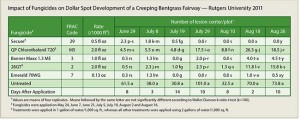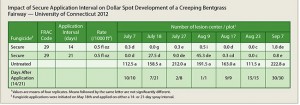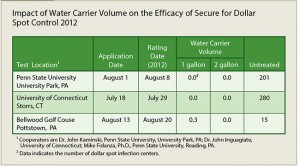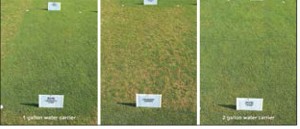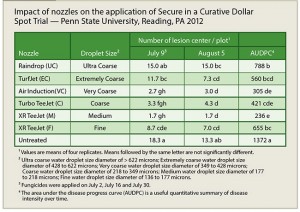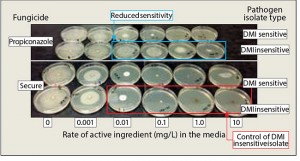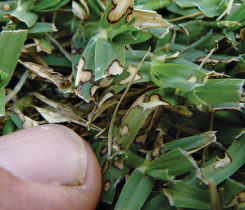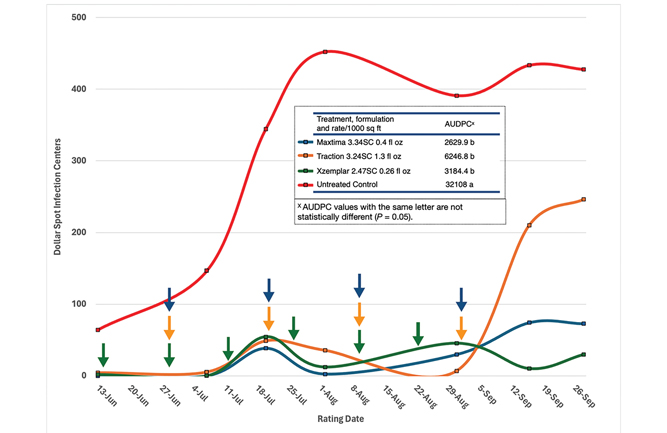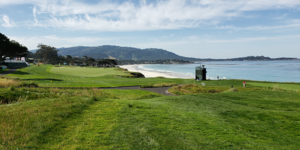Secure fungicide and dollar spot control
No known resistance has developed to Secure, making it an excellent partner for products that require the use of a protectant fungicide with a different mode of action.
Fungicides have been used to control turfgrass diseases since the early 1900s. Up until the late 1960s, fungicides that were developed can be classified as having a multi-site mode of action. Multi-site fungicides, such as chlorothalonil and Mancozeb, are surface protectants (contacts) that disrupt different metabolic processes in the fungal cells (Latin, 2011). With the development of benomyl in 1968 and up to 2012, all fungicides that were introduced into the turfgrass market can be classified as single-site fungicides. These fungicides bind to a specific enzyme or interfere with a single metabolic process within the disease-causing fungus. Most penetrate and translocate in the plant, and many are at risk to the development of fungicide resistance.
In the fall of 2012, Syngenta introduced Secure, the first multi-site fungicide since the registration of Daconil fungicide 2787 in 1966. Secure is a preventive contact fungicide for golf course use that provides control of multiple diseases, including dollar spot, brown patch and leaf spot. The active ingredient in Secure is fluazinam. It is the only turf fungicide in the Pyridinamine chemical class. Classified by the Fungicide Resistance Action Committee (FRAC) in Group 29, fluazinam disrupts the production of energy at multiple metabolic sites within the fungal cell (Anonymous, 2013). This unique class of chemistry, along with its multi-site mode of action, translates to minimal risk of fungicide resistance.
Secure fungicide contains 4.17 pounds of active ingredient (fluazinam) per gallon. The use rate for Secure is 0.5 fluid ounces per 1,000 square feet of turf applied on a 14-day interval. This delivers a very efficacious fungicide at a rate that is 58 to 85 percent less active ingredient per acre than any other multi-site fungicide (Anonymous, 2006, 2011, 2012). The product label allows for a maximum number of 12 applications per year, allowing the golf course to have a multi-site fungicide in every application. As with any multi-site contact fungicide, applications should be made preventively.
Dollar spot (Sclerotinia homoeocarpa F.T Bennett) may well be the most economically important disease on golf course turf. This disease will infect many turfgrass species, but especially creeping bentgrass and annual bluegrass greens, tees and fairways (Latin, 2011). Dollar spot causes sunken, circular patches that measure up to 2 inches in diameter on golf greens and several inches on higher mown turf. Under severe disease conditions, these spots can coalesce, forming irregularly shaped areas.
The dollar spot pathogen survives unfavorable periods as mycelium in plants and as stroma on the leaf surface. The fungus is easily disseminated from plant to plant by mowing and water. When weather conditions favor the fungus, the mycelium will colonize the foliage. These conditions include warm days, high humidity, cool nights and intense dews. Cultural practices such as morning dew removal, minimizing irrigation frequency and applying adequate nitrogen can help reduce dollar spot development, but preventive fungicide applications remain an essential practice for golf course tees, fairways and greens.
While there are many fungicides available for the control of dollar spot, annual application limits and fungicide resistance have created a need for more options. The development of a new fungicide for the control of dollar spot should be accompanied by determination of the optimum application techniques for disease control.
Secure fungicide has been evaluated in dollar spot efficacy trials to compare it to other multi-site fungicides; determine optimal water carrier volume; evaluate its efficacy when applied through different types of nozzles; and demonstrate its effectiveness on DMI-resistant dollar spot.
Efficacy trials
Secure fungicide has proven to be a very effective dollar spot control product. It has performed equal to or better than other dollar spot fungicides. The effectiveness of Secure was demonstrated in a trial conducted by Bruce Clarke, Ph.D., of Rutgers University. The trial was conducted in 2011 at Hort Farm II located in North Brunswick, N.J. on ‘Crenshaw’ creeping bentgrass (Agrostis stolonifera L.) mowed at a height of 0.375 inches. Test plots measured 3 feet by 5 feet and were replicated 4 times. Secure, Chlorothalonil 720 (chlorothalonil) and 26GT (iprodione) were applied in a water volume of 1.0 gal/1,000 square feet and Banner Maxx II (propiconazole) and Emerald (boscalid) were applied in a water volume of 2.0 gal/1,000 square feet. Secure provided nearly 100 percent control for the duration of the trial (Table 1), and it provided significantly better dollar spot control than the untreated plots on all dates. When compared to Chlorothalonil 720 and 26GT, Secure provided significantly better dollar spot control on 4 and 2 rating dates, respectively. Dollar spot control was equal to Banner Maxx II and Emerald, both excellent dollar spot control fungicides. Secure and Chlorothalonil 720 only act on the surface of the plant as a contact fungicide while the other fungicides penetrate the plant to protection from inside the plant.
Another example of Secure’s ability to control dollar spot is shown in a trial conducted by John Inguagiato, Ph.D., of the University of Connecticut. The trial was conducted in 2012 at the Plant Science Research and Education Facility in Storrs, Conn., on “Putter” creeping bentgrass mowed at 0.5 inches. Test plots measured 3 feet by 6 feet. Fungicides were applied in a water volume of 1.0 gal/1,000 square feet. Secure applied on a 14-day spray interval provided greater than 98 percent control (Table 2) despite very severe dollar spot pressure. Secure applied on a 21-day spray interval provided a significant reduction in dollar spot incidence, but this reduction was not agronomically acceptable on 3 of the 7 rating dates. This demonstrated that a more consistent level of control is achieved with a 14-day spray interval.
Water carrier volume
Secure fungicide was tested at three locations to compare its effectiveness when sprayed in different water carrier volumes. The sites included Storrs, Conn.; University Park, Pa.; and Pottstown, Pa. All sites were mowed at 0.5 inches. The Storrs and University Park trials were initiated prior to any disease infection, whereas the Pottstown trial was applied post infection. Secure was applied in a water volume of either 1.0 or 2.0 gal/1,000 square feet. Trials were conducted on creeping bentgrass mowed at 0.5 inches. There were no differences in the dollar spot efficacy of Secure when applied at either water volume (Table 3). This demonstrates the versatility of Secure in controlling dollar spot. Figure 1 demonstrates the effective control of dollar spot by Secure in both water carrier volumes.
Nozzles and water droplet size
Mike Fidanza, Ph.D., of Penn State University, evaluated Secure when applied through six different nozzles that emitted six different droplet sizes. The test site was a creeping bentgrass driving range that was maintained at a height of 0.5 inches. Secure was applied at a rate of 0.5 fl oz per 1,000 sq. ft. to turf that had active dollar spot. The nozzle types and droplet sizes are described in Table 4. The application of Secure through nozzles with droplet sizes in the 177 to 428 micron range provided the best dollar spot control. Secure applied through a nozzle that emitted a droplet size greater than 428 microns or less than 177 microns failed to provide adequate disease control.
Resistance
Secure is ideal for inclusion in programs designed to minimize disease resistance to single-site fungicides when used as a tank-mix partner or alternated in a disease management program. Fungicide resistance commonly develops due to the repeated use of single-site mode of action fungicides. No known resistance has developed to Secure, making it an excellent partner for products that require the use of a protectant fungicide with a different mode of action. In lab studies, Secure fungicide has demonstrated excellent control of dollar spot (Sclerotinia homoeocarpa) strains that are insensitive to DMI fungicides (Figure 2).
Steve McDonald of Turfgrass Disease Solutions (Spring City, Penn.), conducted a curative dollar spot control trial on a golf course fairway with known resistance to benzimidazole and DMI fungicides (Table 5). On October 22, turfgrass treated with Secure had significantly less dollar spot, when compared to the untreated control. Generally, plots treated with Secure had the least amount of dollar spot when compared to all other treatments.
Secure is a novel fungicide that offers the superintendent a valuable tool for the control of dollar spot and other diseases. It allows for the application of a multi-site dollar spot fungicide in every application.
Mike Agnew, Ph.D., and Lane Tredway, Ph.D., are senior technical managers at Syngenta. Agnew can be reached at michael.agnew@syngenta.com.
References
Anonymous. 2013. FRAC Code List *2013: Fungicide Resistance Action Committee.
Anonymous. 2012. Secure fungicide product label. ISK Biosciences Corporation.
Anonymous. 2011. Daconil Ultrex fungicide product label. Syngenta Group Company.
Anonymous. 2006. Fore fungicide product label. Dow AgroSciences LLC, Indianapolis, Ind.
Latin, R. 2011. A Practical Guide to Turfgrass Fungicides. APS Press, St. Paul, Minn.






